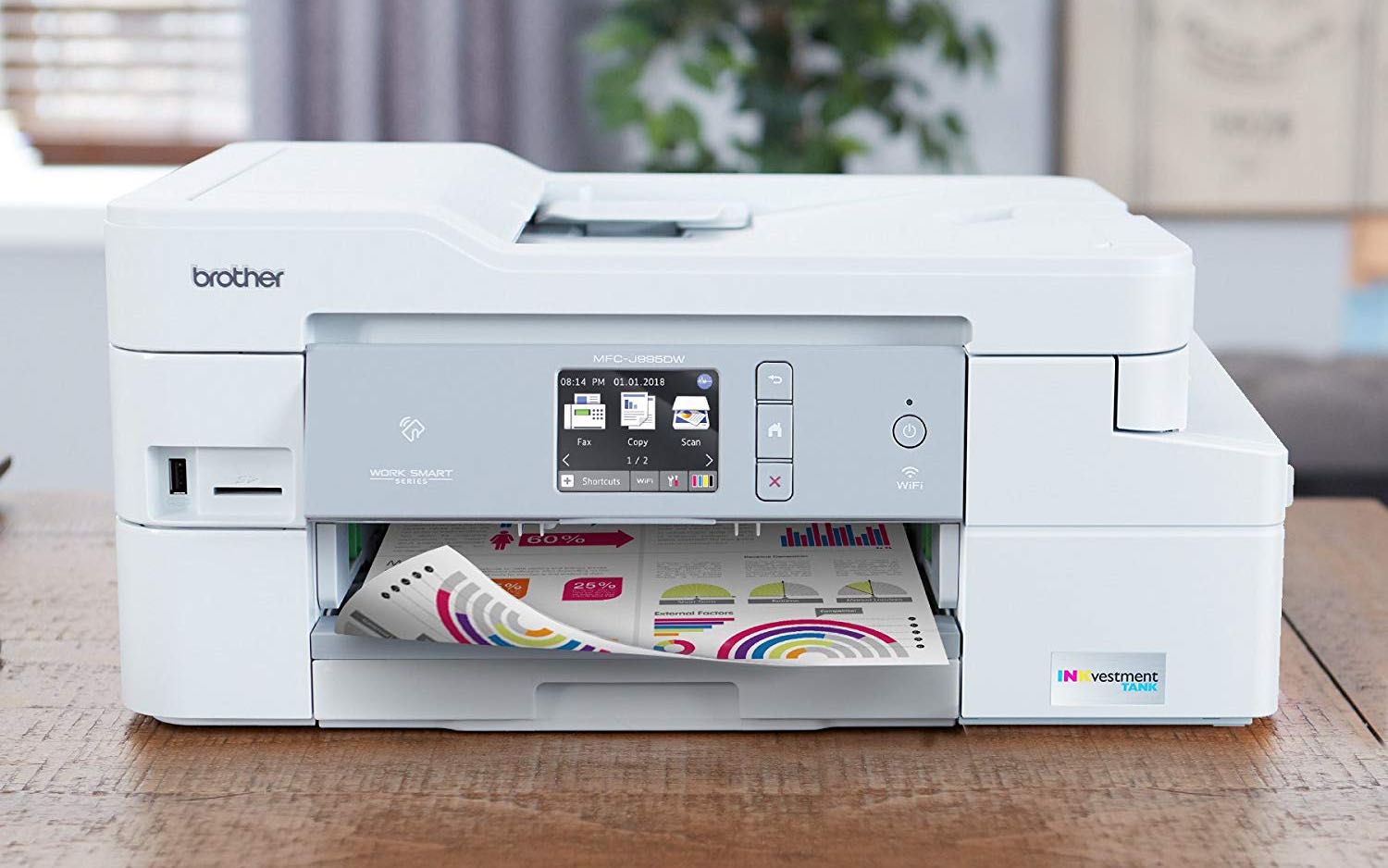Tom's Guide Verdict
The Brother INKvestment MFC-J995DW all-in-one inkjet printer is a solid choice for most tasks, and delivers very low ink costs, though photo printing is inconvenient.
Pros
- +
Very low cost per page
- +
Fast at printing text and graphics
- +
Quick scanning and copying speeds
Cons
- -
Specialty media tray limited to one sheet
- -
Mediocre color-photo scans
- -
Does not make two-sided copies/scans via ADF
Why you can trust Tom's Guide
The Brother INKvestment MFC-J995DW ($179 on Amazon) is an all-in-one inkjet designed for small business/home office use. This model offers a variety of small office features and high-capacity ink cartridges that deliver a very low cost per page. The INKvestment cartridges that come in the box could last as long as a year, according to the company, making it one of the best all-in-one printers we've seen for affordable ink. Given these high ink yields, you might wish this all-in-one had a paper tray with a higher capacity than its 150 sheets.
Of similarly modest capacity, the MFC-J995DW's 20-sheet document feeder and 50-sheet output tray are not well-suited for big jobs. The specialty media tray on the back of the chassis can accommodate only one sheet at a time. Much more impressive is the duplexer, which enables two-sided printing, and is quick.
All things considered, the combination of extremely low ink costs and better-than-average printing and scanning make for one of the best home printers, and our Brother INKvestment MFC-J995DW review explains why.
Brother INKvestment MFC-J995DW review: Design
The front control panel angles upward 45 degrees, which makes it easier to operate the 2.7-inch color touch screen. The touch screen worked well for most menu selections, although entries that require a full QWERTY keyboard to be fit on the screen (such as for a Wi-Fi password) made selections a little difficult for my fingertips. If you place the unit on a low table, you may wish the panel angled upward 90 degrees, such as the Canon Pixma TS9120.
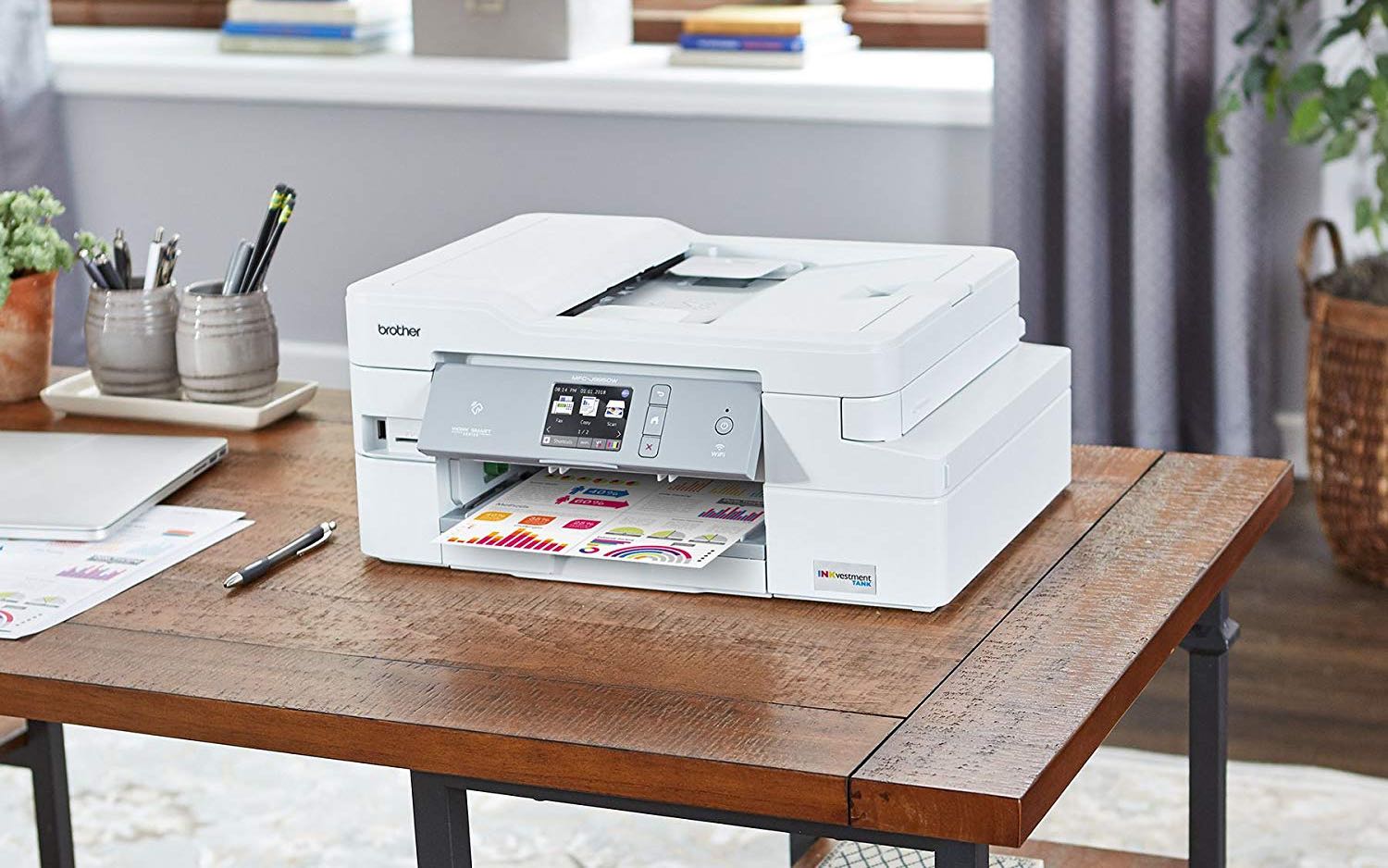
On the lower left of the front panel are an SD Card slot and a USB memory port for printing or scanning to a memory card or USB thumb drive, respectively. When inserting a USB thumb drive, an on-screen menu pops up, offering three options: photo, scan to media, and web (for cloud printing from OneNote or OneDrive, for example). You cannot, however, print PDFs from a thumb drive, only JPEGs, even though you can scan in the PDF format to a thumb drive or an SD Card. When inserting a USB thumb drive, the screen was slow to display the thumbnail previews of the photos, typically taking 2 seconds or more to show the first one.
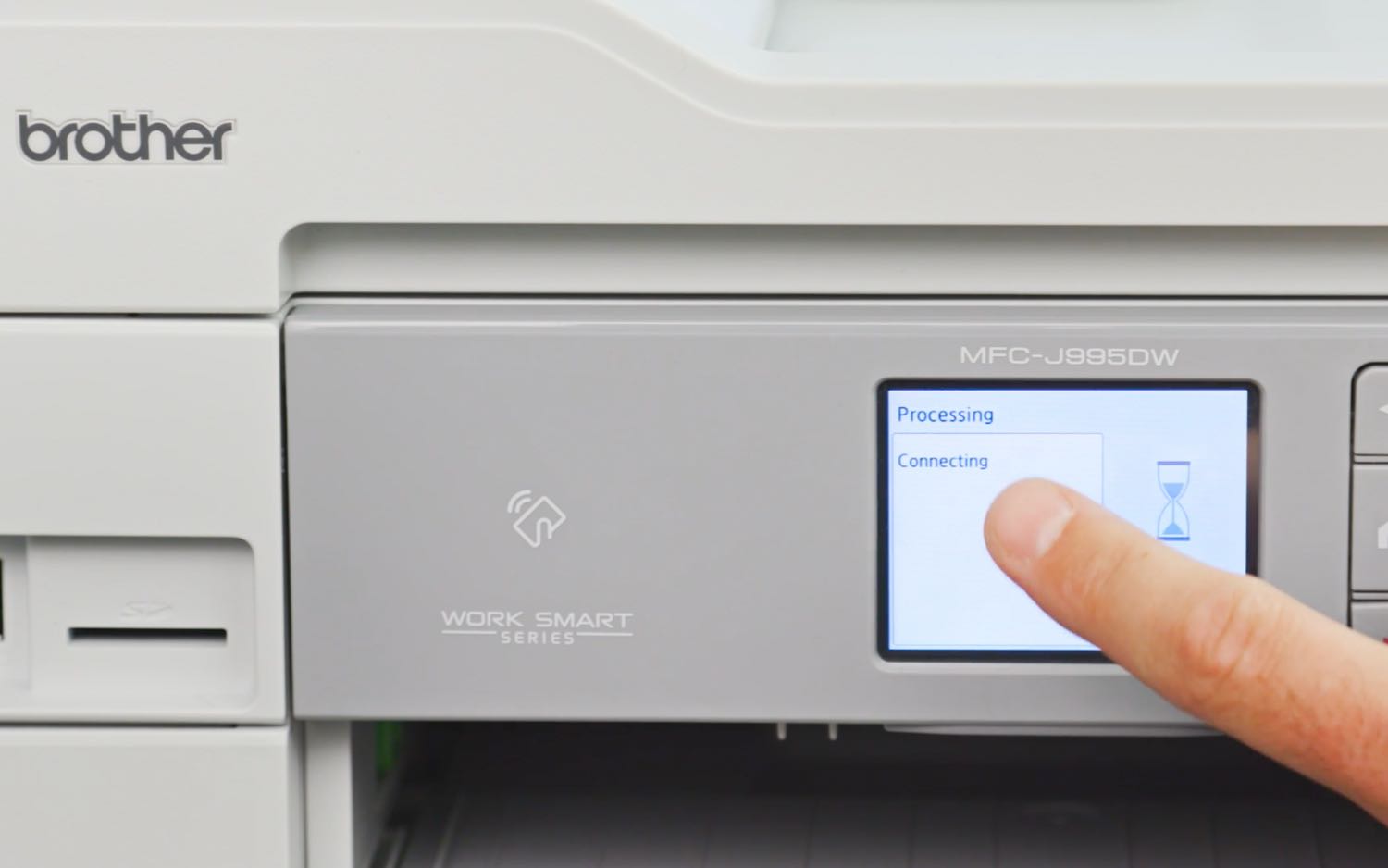
You can connect via wireless, USB and Ethernet, as well as use near-field communication (NFC) for use with a mobile device.
One design oddity is that the USB and Ethernet ports, rather than being on the outside like the fax and telephone extension ports, are inside the body. You have to lift the scanner glass to access them. You will want to have a long cable because this serpentine route to the port eats up about 1.6 feet of cabling. Stranger still is that neither the Quick Setup Guide nor the reference guide show on a diagram where these ports are located. The setup guide includes fax instructions, but no USB or Ethernet instructions (the word "Ethernet" does not even appear in the reference guide).
The INKvestment cartridges that come in the box could last as long as a year, according to the company.
The oddest design quirk, however, is the specialty media tray on the back of the unit. It can hold only one sheet at a time, which makes this model inconvenient for printing multiple photos onto glossy paper, or business documents onto card stock or other specialty media. After inserting a sheet, the touch screen displays a message saying the manual feed slot is ready. The tray can be a little finicky. When I did not fully insert glossy media, my photo print emerged on plain paper without warning, even though I'd selected glossy media in the Brother iPrint & Scan application running on a Windows 10 PC.
Brother INKvestment MFC-J995DW review: Print speeds
Printing onto plain paper in its 150-sheet tray, the MFC-J995DW did not disappoint on small office duties. It printed our five-page text document in 29.1 seconds, or 10.3 ppm, significantly faster than the category average of 34.5 seconds, or 8.7 ppm. Using the duplexer to make two-sided prints, the unit printed text documents at 4 ppm.
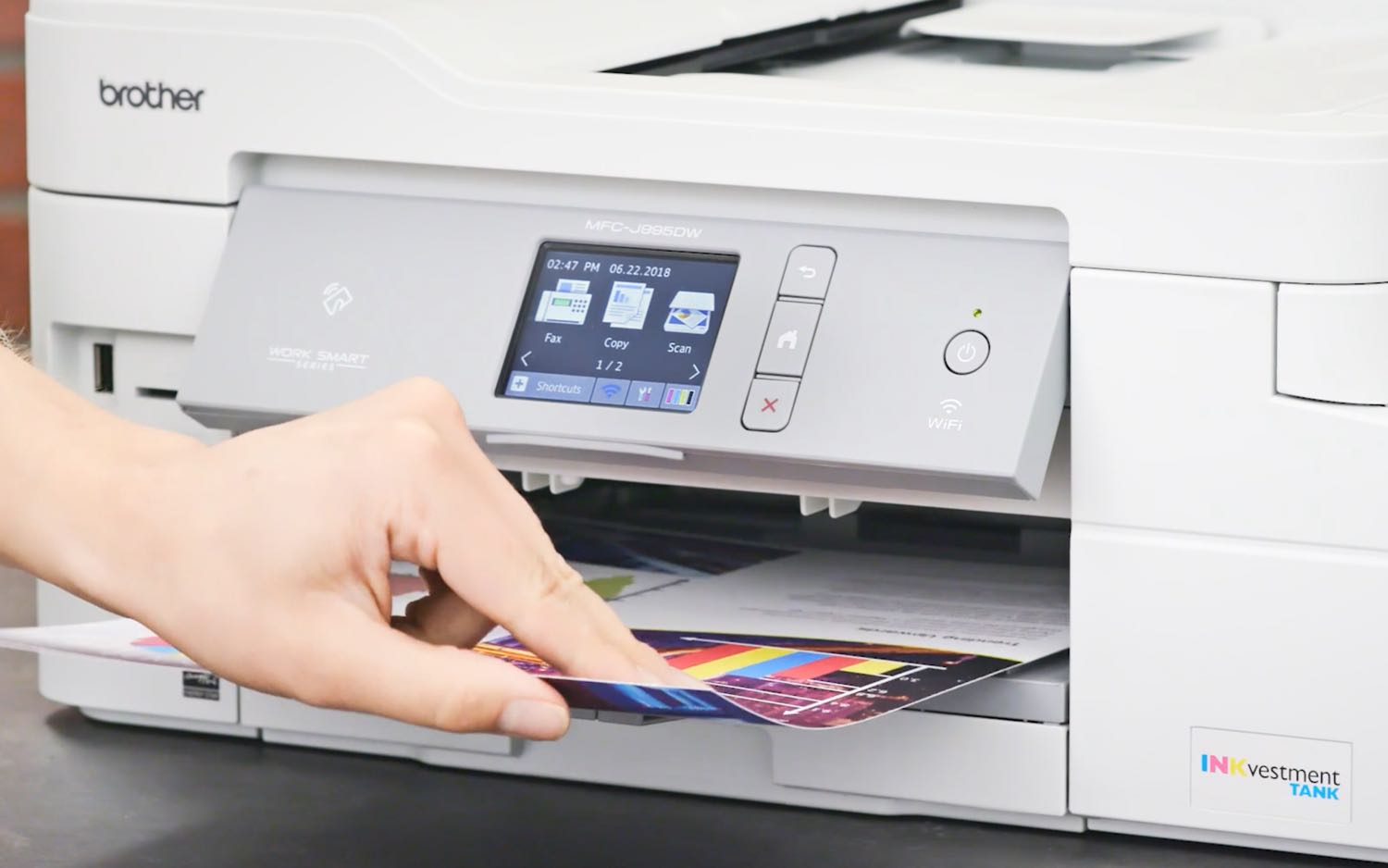
The MFC-J995DW was extremely fast to print mixed text and color graphics, churning out our six-page document in just 1 minute and 13.8 seconds, or 4.9 ppm. This was just a few seconds shy of the fastest model, the Epson XP-640, and far exceeded the average of 2.7 ppm. In fact, the MFC-J995DW made two-sided prints faster than the category average for single-sided prints. It made duplex prints of the same document at an impressive 3 ppm.
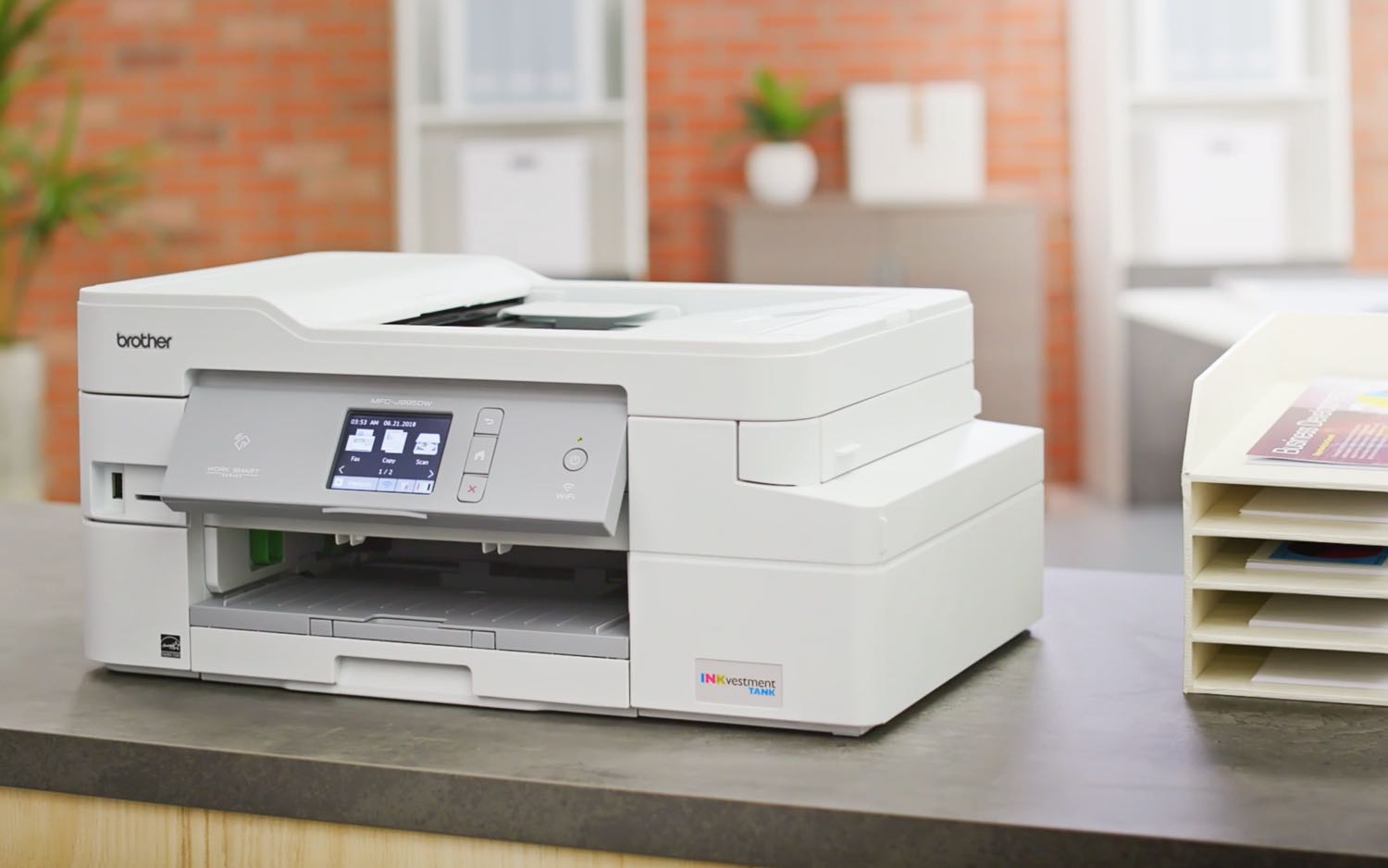
Letter-size glossy photos printed in 4 minutes and 6 seconds, a little faster than the average of 4 minutes and 33 seconds. This was, however, significantly slower than our current Editors' Choice, the Canon Pixma TS9120, which printed the same photo in just 1 minute and 57 seconds.
The MFC-J995DW did not disappoint on small office duties. It printed our five-page text document in 29.1 seconds, or 10.3 ppm, significantly faster than the category average.
Printing was slow from my Android phone. It took 6 minutes for our six-page text and graphics PDF document to print from the Adobe Acrobat app. First, I was prompted to install the Brother Print Service plugin, after which the Adobe Acrobat app warned me that because the Brother print service may send the document through one or more print servers, printing may be slow. It was, taking 6 minutes to print six pages.
Brother INKvestment MFC-J995DW review: Copy and scan speed
The MFC-J995DW was quick to make copies. It made a color copy in just 15.1 seconds — far faster than the average of 25.5 seconds. It was, in fact, the fastest color copier to date in its category, besting the Editor's Choice Canon Pixma TS9120, which made the same copy in 17.3 seconds. Black-and-white copying was similarly quick. The MFC-J995DW made a text copy in 12.7 seconds, compared with 14 seconds for the Canon TS9120 and the category average of 15.2 seconds.
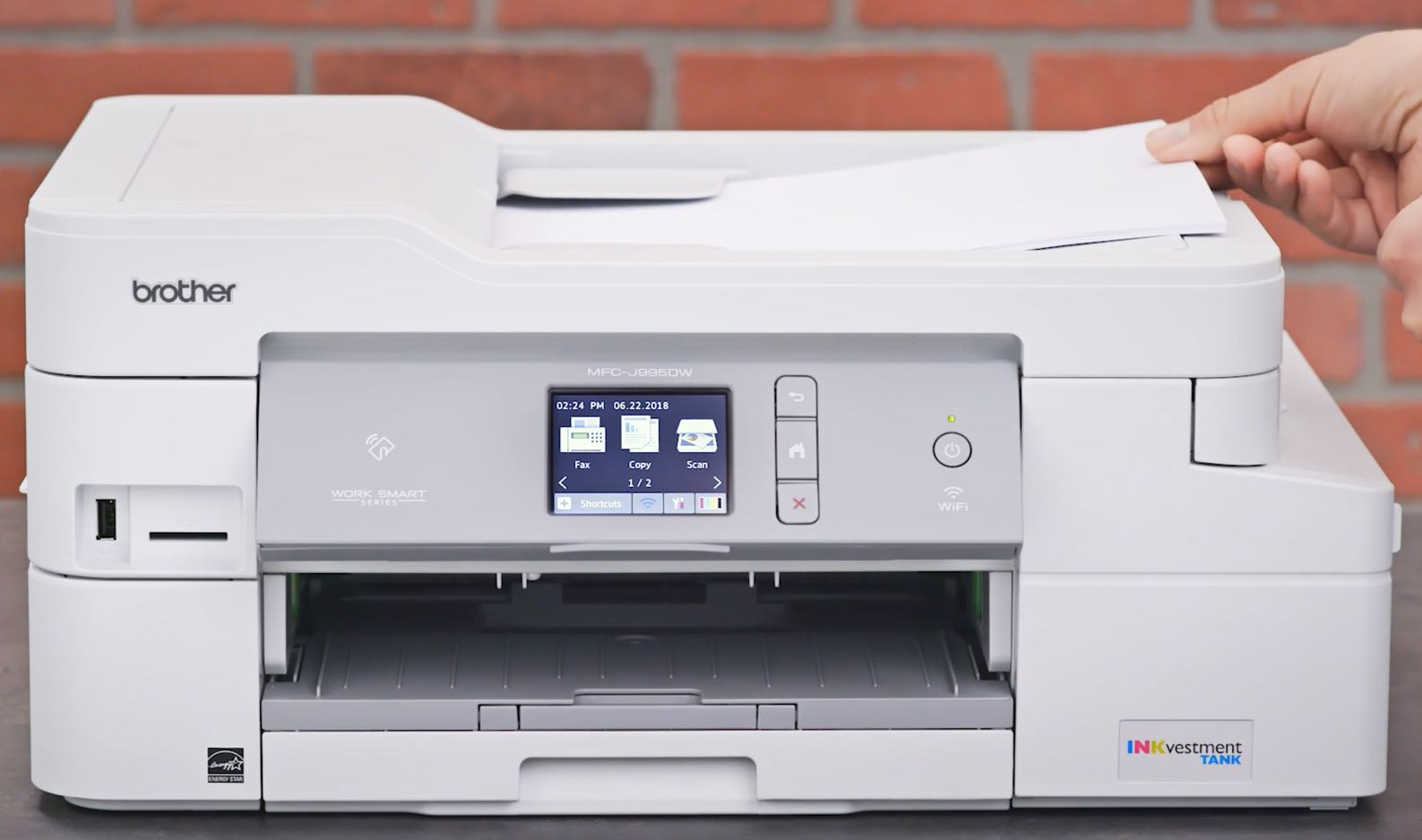
Using the ADF to make single-sided copies of a text document, the MFC-J995DW did so at a speedy 7 ppm — faster than its single-page speed of 4.7 ppm.
The MFC-J995DW was quick to make copies. It was, in fact, the fastest color copier to date in its category.
The all-in-one also proved to be a speedy scanner. It captured a 600 dpi JPEG in just 38.5 seconds, which was much faster than the average of 1 minute and 10 seconds. Only the Editors' Choice Canon TS9120 edged it out, making a scan in 37.8 seconds.
MORE: Best All-in-One Printers - Wireless Inkjet & Laser Printer ...
The Brother also turned in one of the fastest scan times on a black-and-white PDF, making a 300 dpi scan in 7.4 seconds, versus the 10.5 second average. The Canon TS9120 scanned the same document in 7.7 seconds.
Brother INKvestment MFC-J995DW review: Print quality
This Brother all-in-one delivered high print quality across the board. Text looked quite sharp and dark, though not quite as dark as some models. Text in duplex prints came out slightly lighter. Graphics printed with a lot of detail, and colors looked accurate and well saturated. In duplex prints, graphics looked equally attractive as single-sided prints.
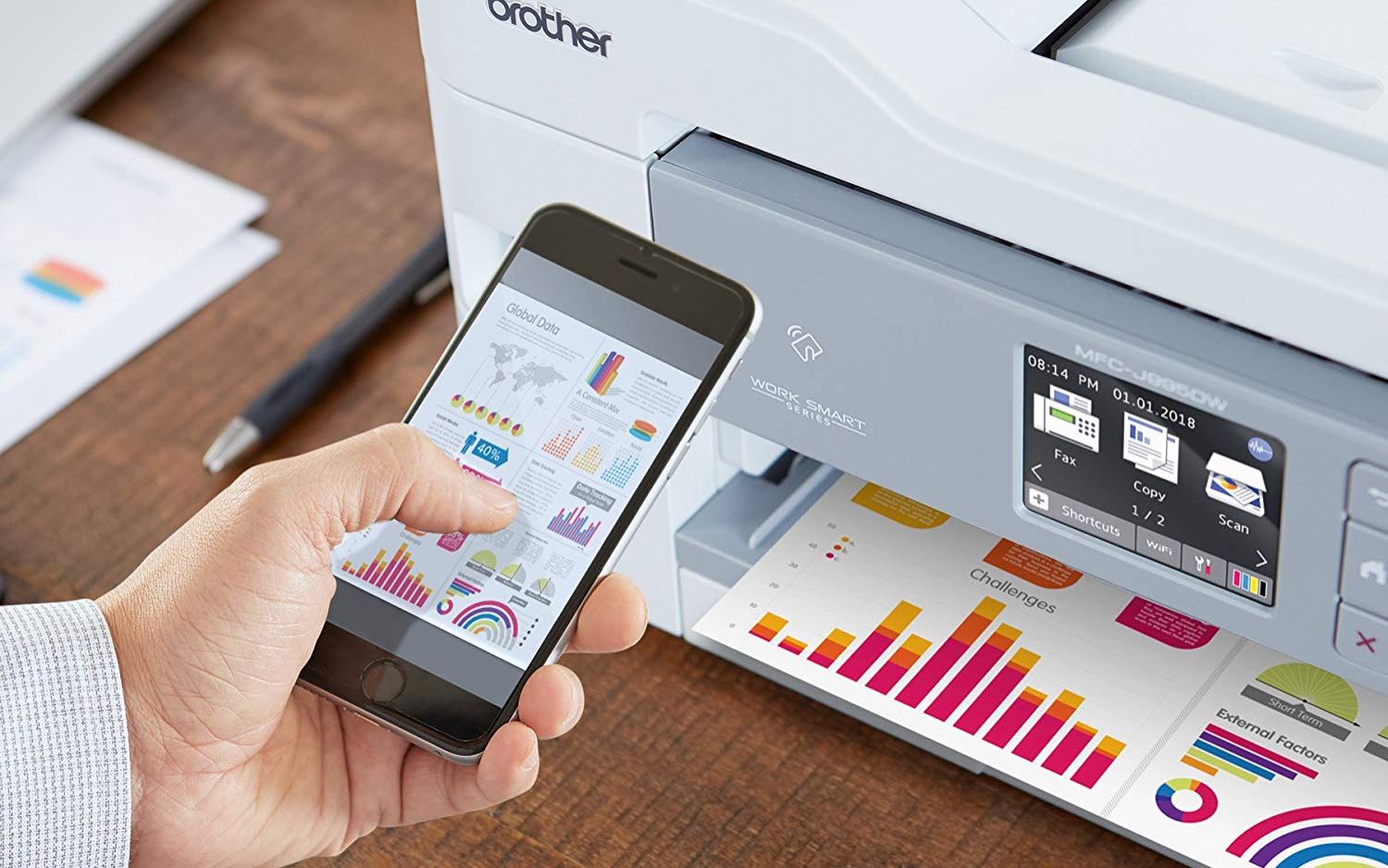
Glossy photos printed with accurate, well-saturated colors, attractive textures and plenty of fine details.
Copies were of a similarly high quality. Both text and graphics were faithfully reproduced. Graphics from magazine pages looked very close to the original, with plenty of detail and accurate color. Converted to black-and-white, copies of the same mixed text and color graphics retained the midtone transitions of the original, and reproduced fine details.
MORE: Epson WF-2760 Review: A Fast Inkjet for a Bargain Price
Scans made to PDF format reproduced crisp text and detailed graphics accurately. However, scans of photographs were less successful. These JPEG scans looked muddy, lacking contrast and bright shades in the original. Details got lost in shadow areas, giving them an overall dull appearance.
Brother INKvestment MFC-J995DW review: Ink cost and yield
Brother offers only high-yield and super high-yield cartridges for this model, called INKvestment ink tanks. For example, while most models offer a black-ink cartridge rated to last a modest 200 or so pages, this all-in-one's lowest yield cartridge is rated to print 3,000 pages.
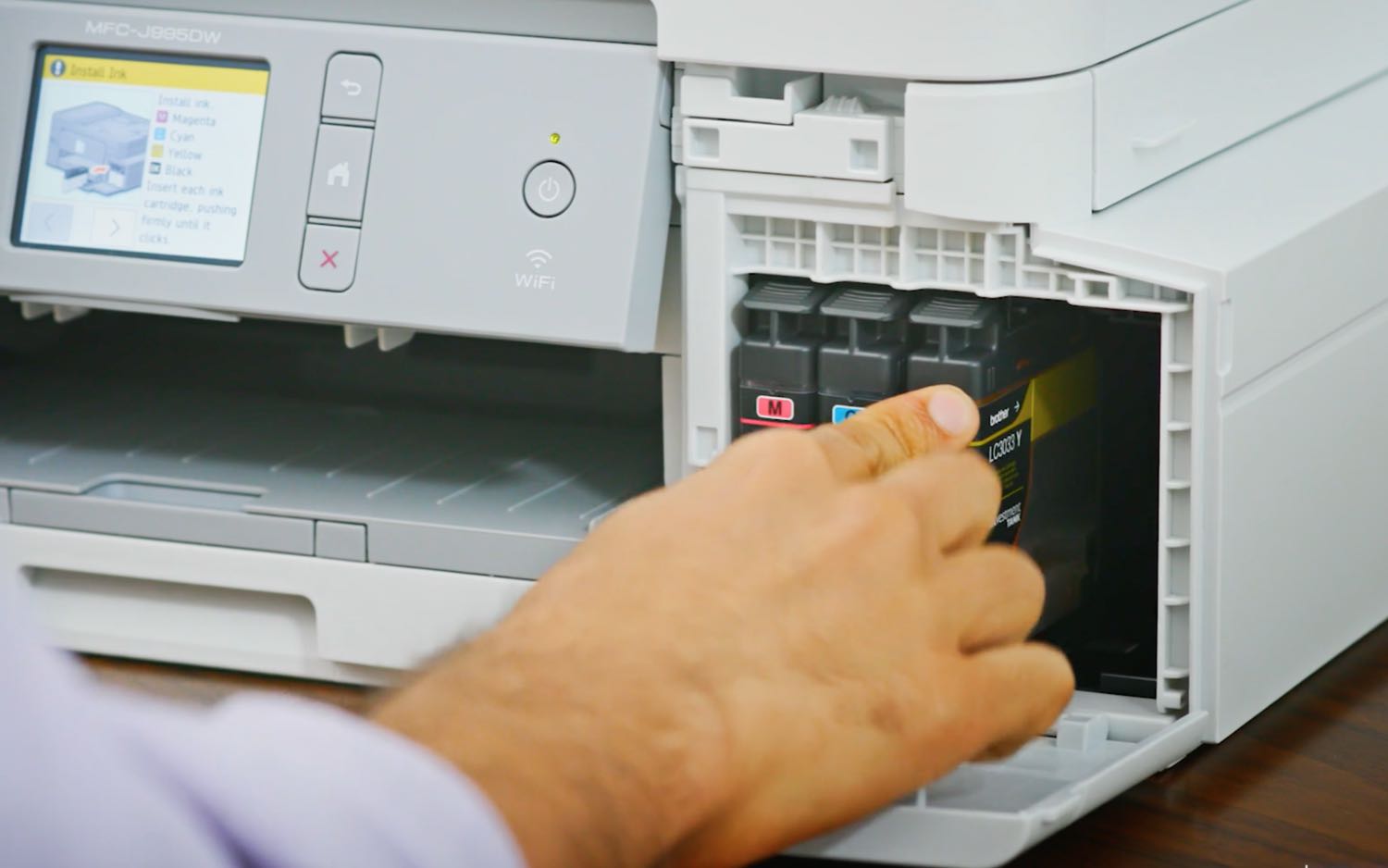
Using the super-high-capacity cartridges, which are rated at 6,000 and 5,000 pages for black and color, respectively, drops cost per page to just 1 cent and 5 cents. This calculation is based on individual purchase of the color cartridges, at $66.50 each (no multipack was listed on the company website at press time, which could lower the color cost per page). The average cost per page with high-yield cartridges is much higher: 5.9 cents (black) and 14.6 cents (color).
While most models offer a black ink cartridge rated to last a modest 200 or so pages, this all-in-one's lowest yield cartridge is rated to print 3,000 pages.
Brother INKvestment MFC-J995DW review: Setup and software
Setting up this all-in-one required only the removal of a few pieces of packaging tape and putting paper in the tray. The ink cartridges are larger than those for most consumer inkjet models, and they are easy to insert in their slots behind a hinged door on the front panel.
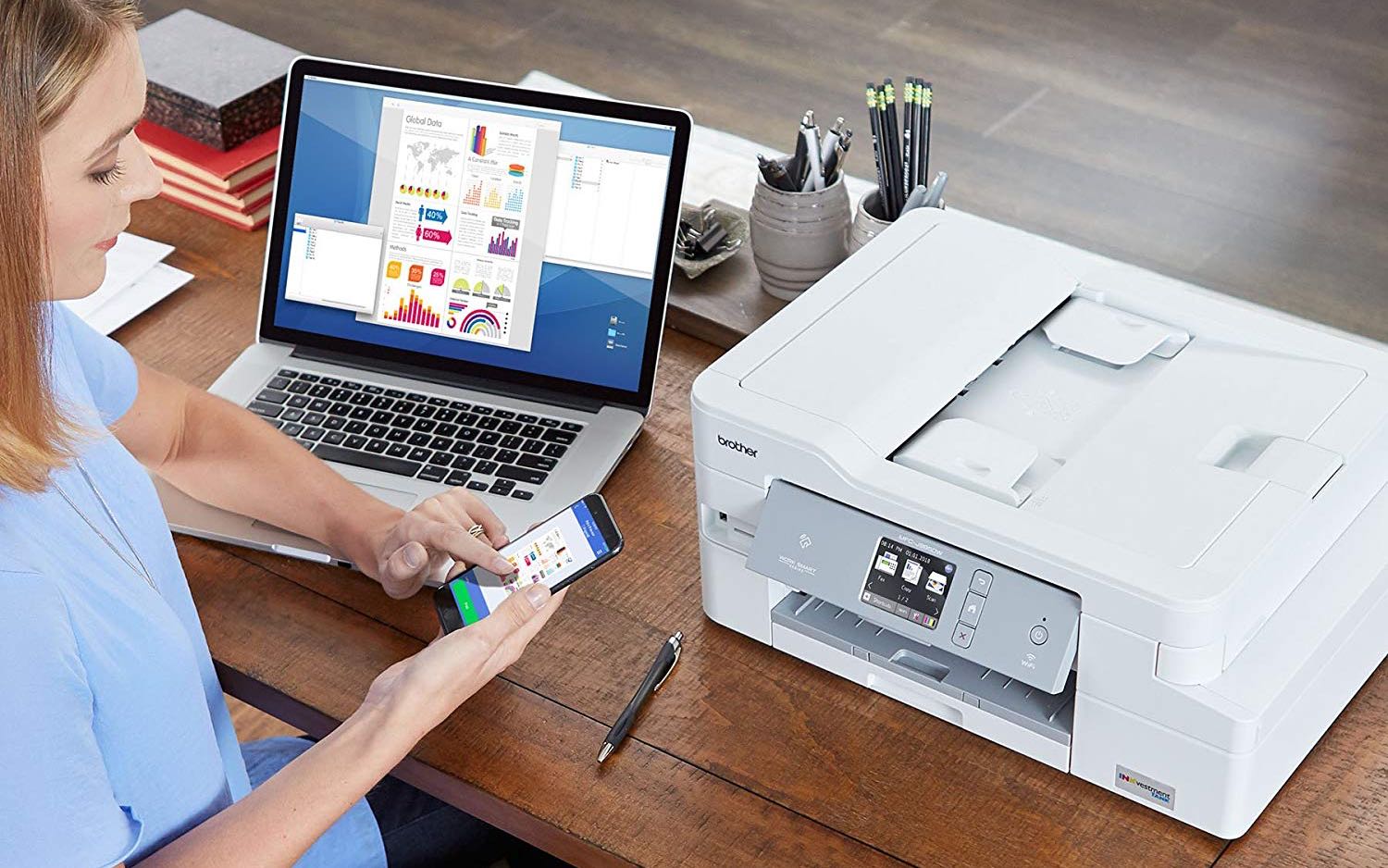
My initial setup on a Windows 10 PC was a piece of cake. The printer showed up without my having to insert the DVD-ROM install disk. But I ran into printing problems because, apparently, Windows ended up creating a duplicate printer profile that caused a conflict once I did run the installation disk. On a Mac running Sierra (10.12), the printer did not show up automatically and I ran the DVD-ROM, which simply sent me online to the Brother support website to perform the download and install.
MORE: Printers - Reviews Articles on Tom's Guide
Beyond those minor quirks, setup was easy. Following instructions and prompts for putting the device on my wireless network was a no-brainer. The MFC-J995DW supports AirPrint, Wi-Fi Direct, Google Cloud Print and NFC for direct connection to a mobile device. The Android app iPrint&Scan allows you to print, scan, copy and fax from a mobile device. You also can check ink levels.
Brother INKvestment MFC-J995DW review: Verdict
Brother's INKvestment MFC-J995DW offers a lot of office-worthy features for a reasonable price, including a fast duplexer. As long as the size of your jobs is modest and are almost exclusively on plain paper, this efficient model is likely to thrill you with its extremely low ink costs. Print, copy and scan quality are all high, as long as you ignore the mediocre scans of photographs. The one-sheet limitation on the specialty paper slot hampers this model's flexibility, as does the modest 20-sheet capacity of the ADF. But if most of your plain paper jobs fit within this range, this money-saving all-in-one is very likely to live up to its duties in your home office.
Credit: Brother
Eric Butterfield is a freelance writer and musician from California. His work has appeared in PC World magazine, CNET, Taproot, and Alter Action — plus Tom's Guide, of course — while his music has appeared in more than 260 TV show episodes for major networks such as NBC, Hulu, BBC America, and more. You can check out his work on Spotify.
